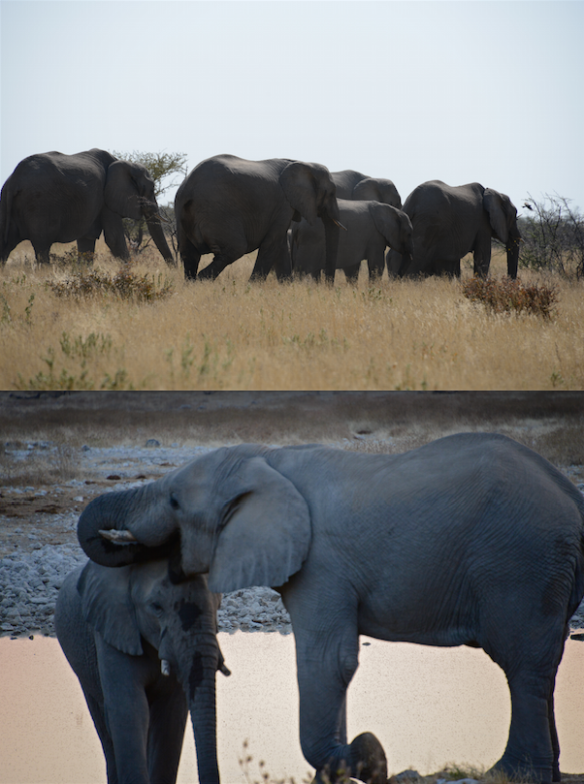
Rajesh Khanna gives Tanuja an unusual jumpstart with a herd of elephants in Haathi Mere Saathi (1971).
Today we present the delightful lyrics and English translation of everyone’s childhood favorite song “Chal Chal Chal Mere Haathi” from Haathi Mere Saathi (1971). Rajesh Khanna star as orphaned Raju who makes fast friends with a herd of elephants that protect him and become like family. Among them, Ramu, is the star elephant who helps Raju build a fortune as a street performer, eventually allowing Raju to build a zoo where the community can share in his love of animals. The song “Chal Chal Chal Mere Haathi” during which Rajesh Khanna and Tanuja fall in love is a quintessential “only-in-Bollywood” moment. Where on earth (besides your wildest fantasies) will you ever see a convertible pushed by a group of elephants as a mechanism of securing the romance?
Tanuja plays the cleverly named Tanu whose gorgeous red Chevrolet Impala convertible breaks down in the middle of the road. Raju happens to arrive at the critical moment to help this damsel in distress! Fortunately, the elephant crew knows how to drive that puppy straight to the heart.

Rajesh Khanna rubs noses with his favorite elephant and they both look happy AF.
Kishore Kumar lends his rich voice to Laxmikant-Pyarelal’s playful composition. Anand Bakshi’s lyrics burst with flirtatious overtures as well as underhanded zingers while the singer teasingly appears to solely address the elephants the entire time. A hearty trumpet is gloriously sprinkled throughout the song’s score as a substitute for the elephants roaring their approval. Be sure to watch extra carefully during the swift stunt in which Rajesh Khanna appears to float to the top of the elephant. Anyone who has taken a good old-fashioned haathi ride during a trip to the motherland knows ascending the elephant is NEVER this graceful. Thank you, awkwardly crouched production assistants who gave our hero the leg-up!

Tanuja pretends to drive as Rajesh Khanna whistles flirtatiously in her ear in Haathi Mere Saathi (1971). I mean it, take off those driving gloves, we all know steering is futile.
So pull up a high-chair and reel your kids in for this one. They’re going to love our English translation of the lyrics of “Chal Chal Chal Mere Haathi” and you’ll be glad a world still exists this innocent and colorful, even if only for a few minutes on-screen. Follow along with the video here and enjoy our translation below!
Chal Chal Chal Mere Haathi Lyrics and English Translation:
Chal chal chal mere saathii, O mere haathii
Let’s go, my companion, O my elephant
Chal le chal kaTaaraa khii.Nch ke
Come pull this piece of junk
Chal yaar, dhakka maar
Go on, friend, push!
Band hai moTar kaar
The motor car is broken down
Chal yaar dhakka maar
Go on, friend, push!
Chal chal chal mere saathii…
Phuulo.N se naazuk hai woh, moTar mei.N baiThii hai jo
She who sits in the car is more delicate than a flower
Aahistaa aahistaa chal, usko na taqliif ho
Go carefully, let her not experience any trouble
Haaye, haaye, kha na jaaye
Haaye, haaye, let it not consume me
Uskii naazuk kamariiyaa bal, chal!
The swaying of her delicate hips, let’s go!
Chal chal chal mere saathii…
Khidmat terii kaam de, shaayad woh inaam de
If your service is successful, perhaps she will reward you
Kar us hasii.N ko salaam, aa.Nkhon se paighaam de
If you salute the beautiful lady, she may send you a message through her eyes
Paas aaja, O sun raajaa
Come close, listen O King
Aisa mauqaa na jaaye nikal, chal!
Let this chance not escape, let’s go!
Chal chal chal mere saathii…
Tuu yaaro.N ka yaar hai, kitnaa vafaadaar hai!
You are a friend of friends, how faithful you are!
JhuuTha hai saaDaa jahaa.N, sachcha teraa pyaar hai
The rest of the world may be a lie, but your love is honest
Tuu paglaa, na badalaa!
You crazy creature, do not change!
SaDii duniyaa gayii hai badal, chal!
Even if the whole world has changed, let’s go!
Chal chal chal mere saathii…
Glossary:
saathi: companion; haathi: elephant; kaTaaraa: junk, jalopy; khee.Nchnaa: to pull; dhakka maarna: to push; band hona: to be broken, to be closed; yaar: friend; phuul: flower; naazuk: delicate; baiThnaa: to sit; aahistaa: carefully; taqliif: trouble, problem; khaanaa: to eat, to consume; kamariiyaa: small waist; bal: sway; khidmat: service; kaam dena: to be successful; shaayad: perhaps; inaam: reward; hasii.N: beautiful lady; aa.Nkh: eye, paighaam: message; paas: near, close; aa jaanaa: to come here; sunnaa: to listen; raajaa: king; mauqaa: chance, opportunity; nikalnaa: to escape, to go out; vafaadaar: faithful; jhuuTaa: lie; sachchaa: truth; pyaar: love; paglaa: crazy person; badalnaa: to change; duniyaa: world

Shots of a herd of African elephants I encountered while on a safari in Namibia with my husband recently. Can you guess which song was stuck in my head the whole time?
Ramu and Raju’s friendship are everyone’s bestie goals. They have each other’s backs like nobody’s business. Haathi Mere Saathi (1971) is truly the Bambi (1942) of Bollywood–and every child will remember exactly how they felt the first time they experienced the trauma of the film’s ending. Wow, there is just so much dust flying around my house lately, my eyes really need to stop watering. Stop, get a grip on yourself, Mrs. 55. SERIOUSLY, TOO MUCH DUST, WHY ARE MY EYES SO SENSITIVE.

Even though your outfit is the color of pepto bismol, you da man, Rajesh Khanna.
This one-of-a-kind song was requested by fan Janaki. Awesome choice! We know we’ve been slower to post lately with the busy year, but requests like these are always inspiring. We love hearing from fans!
-Mrs. 55
















